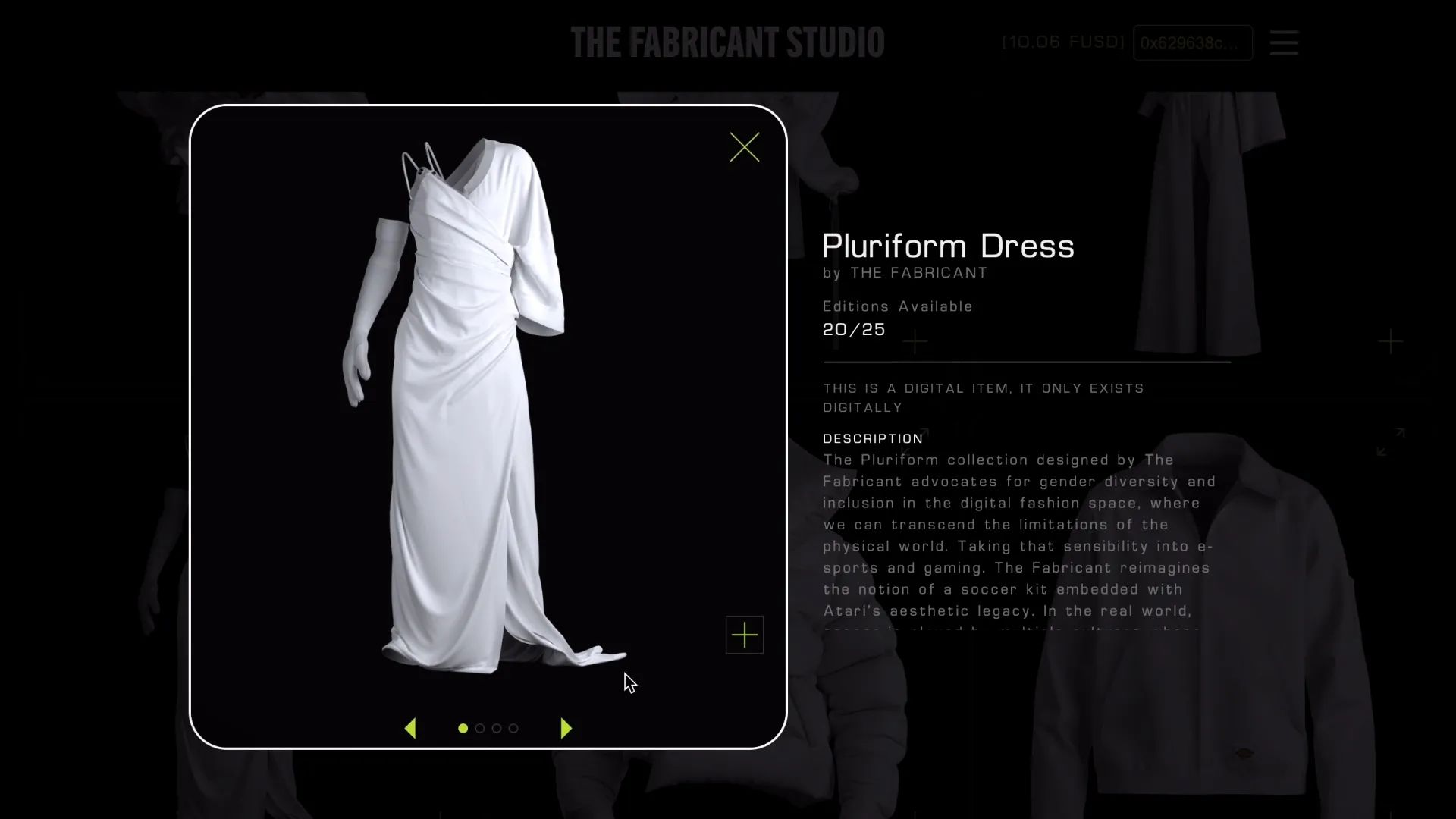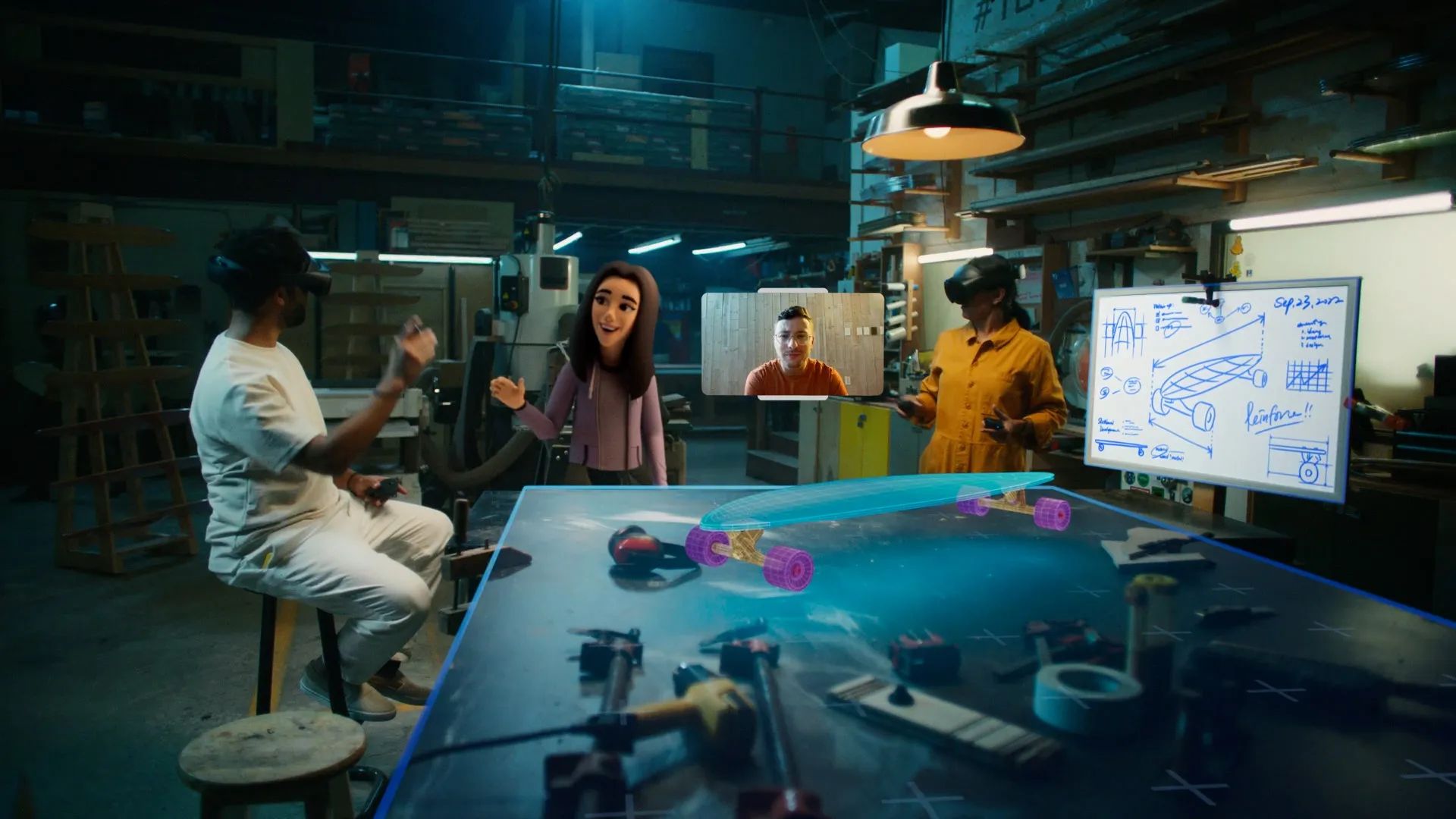Introduction
Welcome to the exciting world of the metaverse, where digital experiences blend seamlessly with reality. With the rise of virtual and augmented reality technologies, the concept of the metaverse has become a hot topic of discussion. In this digital realm, people can interact, socialize, work, and even dress up their avatars with unique digital clothing.
The metaverse, a term coined by science fiction writer Neal Stephenson in his 1992 novel “Snow Crash,” refers to a virtual universe that spans multiple worlds or realities. It is an immersive, interconnected space where users can navigate and engage in various activities. As the metaverse gains traction, the demand for digital clothing to dress up avatars has surged, creating new opportunities in the fashion industry.
Digital clothing offers a plethora of benefits. It allows for self-expression and creativity beyond the limitations of physical fashion. You can experiment with styles, colors, and designs without the constraints of fabric and production costs. Additionally, digital clothing is sustainable and eco-friendly, eliminating the need for physical production and reducing waste.
If you’re intrigued by the idea of creating digital clothing for the metaverse, you’re in the right place. In this article, we’ll explore the tools, techniques, and steps involved in bringing your imagination to life and designing virtual garments that will make your avatars stand out in the metaverse.
Understanding the Metaverse
The term “metaverse” may sound futuristic, but its concept has been evolving for decades. It refers to a virtual reality space where users can interact with a computer-generated environment and other users. In the metaverse, individuals can navigate through virtual worlds, communicate with others, and engage in activities such as gaming, shopping, working, and even attending virtual events.
What sets the metaverse apart from traditional online experiences is its immersive nature. While browsing the internet or using social media platforms, users mainly consume content passively. In contrast, the metaverse allows for active participation and collaboration within a shared virtual environment.
As technology progresses, the metaverse is becoming more realistic and interconnected. It merges the physical and digital worlds by integrating augmented reality, virtual reality, and mixed reality technologies. This convergence enables users to have seamless experiences and interactions, blurring the boundaries between what is real and what is virtual.
One of the driving forces behind the development of the metaverse is the desire for increased connectivity and socialization. As people become more isolated in the physical world, virtual communities provide an opportunity to connect with others who share common interests. The metaverse fosters social interactions, enabling users to form relationships, collaborate on projects, and engage in shared experiences.
Another key aspect of the metaverse is its potential for economic activities. In addition to socializing, users can buy and sell virtual goods and services within the metaverse. This has given rise to a new digital economy, where virtual currencies and assets hold real-world value. Virtual fashion, including digital clothing, has emerged as a significant market within the metaverse, allowing users to express their personal style and enhance their virtual identities.
It is essential to understand the metaverse’s evolving nature as it continues to expand and evolve. As technology advances and more companies invest in the development of virtual experiences, the metaverse will undoubtedly become an integral part of our daily lives, offering endless possibilities for creativity, exploration, and connectivity.
The Rise of Digital Clothing
In the world of the metaverse, physical limitations no longer bind fashion enthusiasts. Digital clothing has gained significant popularity, as it allows users to dress up their avatars in unique and stylish garments. This emerging trend has opened up new opportunities for designers, fashion brands, and even individuals to explore the creative possibilities of virtual fashion.
One of the primary drivers behind the rise of digital clothing is the desire for self-expression and personalization. Avatars serve as digital representations of individuals in the metaverse, and just as people express their style through physical clothing, digital fashion allows users to showcase their unique tastes and preferences. Whether it’s bold, futuristic designs or classic and elegant attire, digital clothing offers endless possibilities to create a virtual identity that aligns with their personality.
Virtual fashion also provides a means for users to stand out and differentiate themselves in the metaverse. With a growing number of individuals participating in virtual events, having eye-catching and distinct garments can help users make a statement and leave a lasting impression on others. Designers and fashion brands have recognized this potential, leading to collaborations between virtual and physical fashion worlds.
The sustainability aspect of digital clothing cannot be ignored. As environmental concerns become increasingly prevalent, the fashion industry is facing scrutiny due to its contributions to pollution and waste. Digital clothing minimizes the negative impact by eliminating the need for physical production and reducing clothing waste. Users can continually update and modify their virtual wardrobe without generating any environmental harm, making digital fashion a more sustainable alternative.
The economic potential of digital clothing is also significant. Virtual fashion marketplaces have emerged where users can buy, sell, and trade digital garments. This has created a new avenue for designers and independent creators to showcase and monetize their work. Additionally, fashion brands can extend their reach into the metaverse, reaching a new and potentially global audience.
Interestingly, digital clothing is not limited to the metaverse alone. With the rise of augmented reality and virtual try-on technology, users can now virtually try on and purchase digital clothing to enhance their online presence and engage with their followers on social media platforms. This further blurs the lines between physical and virtual fashion, creating exciting opportunities in the digital realm.
As the metaverse continues to expand and captivate users worldwide, the demand for digital clothing will only grow. From self-expression to sustainability and economic potential, the rise of digital clothing represents a captivating intersection of fashion and technology that paves the way for a new era of fashion innovation.
Tools and Software for Creating Digital Clothing
To bring your digital clothing designs to life, you’ll need access to the right tools and software. Fortunately, there are various options available that cater specifically to the creation of virtual garments. Here are some essential tools and software that can help you get started:
- 3D Modeling Software: A powerful 3D modeling software is essential for creating the virtual clothing designs. Autodesk Maya, Blender, and ZBrush are popular choices among designers. These tools provide a vast range of features, allowing you to sculpt, texture, and render your garments with precision.
- Marvelous Designer: Marvelous Designer is a specialized software designed specifically for creating digital clothing. It offers a user-friendly interface and intuitive tools that simulate fabric behavior, allowing you to drape, sew, and simulate realistic clothing patterns. With Marvelous Designer, you can achieve realistic folds, wrinkles, and movement in your digital garments.
- Texturing Tools: To add texture and detail to your digital clothing, you’ll need texturing tools. Substance Painter and Photoshop are widely used for creating texture maps, adding color, patterns, and surface details to your garments. These tools enable you to achieve realistic materials like silk, leather, or denim.
- Rigging Software: Rigging is the process of adding a skeleton and joints to your digital garments to allow them to move and deform realistically. Autodesk Maya, 3ds Max, and Blender offer robust rigging tools that enable you to control the movement and flexibility of your clothing when worn by avatars.
- Weight Painting Tools: Weight painting is a crucial step in rigging, as it determines the influence of the bones on the clothing’s vertices. Blender and Maya have built-in weight painting tools that allow you to assign specific weights to different parts of your digital clothing, ensuring proper movement and deformation.
- Metaverse Platform Tools: Depending on the metaverse platform you’re designing for, you may need to use specific tools or software development kits (SDKs). Unity and Unreal Engine are popular platforms that provide extensive development tools and SDKs for building virtual environments, including clothing systems.
It’s worth noting that while these tools and software are highly effective, they may have a learning curve. Take the time to familiarize yourself with the features and functionalities of each tool and experiment with different techniques to achieve the desired results. Additionally, there are plenty of online tutorials, forums, and communities where you can seek guidance and learn from experienced digital fashion creators.
By leveraging these powerful tools and software, you can unlock your creativity and bring stunning virtual clothing designs to life in the metaverse.
Step-by-Step Guide to Creating Digital Clothing
Creating digital clothing for the metaverse requires a systematic approach and attention to detail. Here is a step-by-step guide to help you bring your virtual garment designs to fruition:
- Designing the Look and Style: Start by sketching out your ideas and creating concept art for your digital clothing design. Consider the aesthetics, silhouette, and overall style you want to achieve. Pay attention to the proportions and details that will make your design visually appealing.
- Choosing the Right Texture and Material: Determine the material and texture you want to simulate for your virtual garment. This could be anything from silk, denim, or leather. Use texturing tools such as Substance Painter or Photoshop to create realistic material attributes like color, patterns, and surface details.
- Adding Details and Accessories: Enhance your digital clothing design by adding details such as buttons, zippers, pockets, or embellishments. Pay attention to the small elements that will elevate the design and make it stand out.
- Rigging and Weight Painting: Rig your digital clothing using 3D modeling software such as Autodesk Maya or Blender. Add a skeleton and joints to enable realistic movement and deformation. Use weight painting tools to assign proper weights to the clothing’s vertices, ensuring it moves naturally when worn by avatars.
- Test and Refine: Import the rigged digital clothing into a metaverse platform or rendering software to see how it looks in action. Test the movement and interaction with avatars to identify any issues or areas that require improvement. Make necessary adjustments to achieve the desired results.
- Exporting and Importing to the Metaverse Platform: Once you’re satisfied with the design and functionality of your digital clothing, export it in a compatible file format. Different metaverse platforms have specific requirements, so ensure you understand the file format and import process for your chosen platform. Unity or Unreal Engine are commonly used platforms for importing and testing digital garments.
- Market and Showcase Your Designs: Share your creations with the metaverse community on marketplaces, social media platforms, or virtual fashion events. Collaborate with influencers, fashion brands, or metaverse content creators to showcase your designs to a wider audience and gain recognition for your work.
Remember, creating digital clothing is an iterative process. Be open to feedback, continuously refine your designs, and explore new techniques to push the boundaries of virtual fashion. With practice and persistence, you’ll be able to create stunning virtual garments that capture the attention and admiration of metaverse residents.
Designing the Look and Style
When creating digital clothing for the metaverse, designing the look and style of your garments is a crucial first step. This stage sets the foundation for your design and determines the overall aesthetic appeal. Here are some key considerations and steps to guide you in designing the look and style of your virtual clothing:
- Research and Inspiration: Begin by gathering inspiration from various sources such as fashion magazines, runway shows, virtual fashion trends, or even nature and art. Explore different styles, eras, and cultural influences to broaden your creative perspective.
- Sketching and Conceptualization: Translate your ideas and inspiration into sketches and concept art. Sketching helps visualize your design, explore different silhouettes, and experiment with proportions. Focus on capturing the essence of your vision on paper before moving to the digital realm.
- Consider the Avatar: Keep in mind the identity and characteristics of the avatars that will wear your digital clothing. Research the typical body proportions and movement range in the metaverse platform you’re designing for. Adapt your design to ensure it fits well and moves naturally on avatars.
- Experiment with Shapes and Proportions: Play with different shapes, cuts, and proportions to create intriguing and unique designs. Experiment with asymmetry, oversized or fitted styles, and varying lengths to add visual interest and distinguish your virtual garments.
- Color and Pattern Selection: Choose a color palette that complements your design concept and reflects the desired mood or theme. Consider the impact of colors in the metaverse environment and how they interact with lighting and shading. Experiment with patterns and textures to add depth and visual appeal to your virtual clothing.
- Focus on Detailing: Pay attention to the smaller details that elevate your design. Consider the placement of buttons, seams, stitching, or other features that add authenticity to your virtual garments. These subtle details can make a significant difference in the overall visual impact.
- User Experience: Think about the user experience when designing the look and style of your digital clothing. Consider how easy it will be to put on and take off the virtual garment, how it will fit with different avatar body types, and how comfortable it will be to wear during various metaverse activities.
Remember to push your creative boundaries, experiment with different styles and aesthetics, and be open to exploring new design concepts. The metaverse provides an opportunity to challenge traditional fashion norms and create avant-garde virtual garments that captivate and inspire.
Choosing the Right Texture and Material
When creating digital clothing for the metaverse, choosing the right texture and material is essential to bring your virtual garments to life and make them visually appealing. The texture and material you select will define the look, feel, and realism of your digital clothing. Here are some key considerations when choosing the texture and material for your virtual garments:
- Research Real-World Fabrics: Familiarize yourself with different types of fabrics and their characteristics in the physical world. Understand how they drape, reflect light, and react to movement. This knowledge will help you simulate the desired look and feel of the fabric in your virtual clothing.
- Reflect the Design Concept: Consider the design concept and overall look you want to achieve with your digital garments. The texture and material should align with the concept and enhance the intended aesthetic. For example, a futuristic design may call for metallic or high-gloss materials, while a vintage-inspired piece may require textured fabrics like lace or tweed.
- Consider the Metaverse Platform: Take into account the platform or rendering engine you’re designing for. Some platforms have limitations on the types of textures and materials that can be realistically rendered. Familiarize yourself with the platform’s capabilities and optimize your design accordingly.
- Texture Mapping: Utilize texturing tools such as Substance Painter or Photoshop to create realistic texture maps for your digital clothing. Pay attention to details like color, patterns, and surface imperfections that will add depth and realism to the material. Experiment with different texture mapping techniques to achieve the desired effect.
- Simulate Fabric Behavior: Virtual fabrics should behave as realistically as possible. Consider how the chosen material will drape, fold, crease, or stretch when the avatar moves. Simulate these behaviors using software like Marvelous Designer, which allows you to control the physics and simulation of virtual fabric.
- Lighting and Shading: Keep in mind how lighting and shading in the metaverse platform will interact with your chosen texture and material. Take into account the direction and intensity of light sources, as well as the environment’s overall lighting conditions. Adjust the shading and reflectivity of the material to create a more believable and visually pleasing effect.
- Experiment and Iterate: Don’t be afraid to experiment and iterate with different texture and material options. Test how different fabrics and textures look on your virtual clothing design and make adjustments as needed. Seek feedback from others and observe how the material appears in different lighting and movement scenarios.
By selecting the right texture and material for your digital garments, you can create visually stunning and realistic virtual clothing that enhances the overall immersion and visual appeal of the metaverse experience.
Adding Details and Accessories
When creating digital clothing for the metaverse, adding details and accessories is a crucial step to enhance the overall design and make your virtual garments stand out. Details and accessories provide depth, personality, and a unique touch to your digital clothing creations. Here are some key considerations when adding details and accessories to your virtual garments:
- Focus on the Essence of the Design: Consider the overall design concept and aesthetic of your digital clothing. Pay attention to the core elements that define your design, and choose details and accessories that align with that vision. For example, if you’re aiming for a minimalist design, opt for subtle and understated details.
- Balance and Composition: Strive for a balanced composition when adding details and accessories. Consider the placement and proportion of each element to ensure they complement the overall design without overpowering it. Aim for harmony and coherence in the arrangement of buttons, zippers, pockets, or any other elements.
- Experiment with Embellishments: Explore different embellishments to add interest and personality to your digital clothing. This could include beading, embroidery, sequins, or decorative stitching. Experiment with different techniques and textures to create eye-catching and unique details.
- Consider Functionality: While digital clothing doesn’t have functional requirements like physical clothing, considering the perceived functionality can add authenticity. For example, adding functional-looking buttons or realistic pockets can give the impression of functionality and enhance the immersive experience for users.
- Accessories and Complementary Items: Consider adding accessories that complement your virtual garment. This could include belts, scarves, hats, or jewelry. Accessories can elevate the overall look, add visual interest, and provide opportunities for personalization and self-expression for users.
- Customization Options: Provide customization options for users to personalize their virtual garments. This could include interchangeable buttons, color variations, or detachable elements. Offering customization adds value and allows users to create a unique and personalized wardrobe in the metaverse.
- Attention to Detail: Pay attention to the finer details when adding accessories. Consider the material, texture, and color of the accessories to ensure they align with the overall design aesthetic. Refine and iterate on the details to achieve the desired level of realism and visual impact.
Adding details and accessories to your digital clothing design can elevate the overall look and make your virtual garments more visually appealing and engaging. By considering the essence of the design, balance, functionality, and customization options, you can create stunning virtual clothing that captivates and adds a unique touch to the metaverse experience.
Rigging and Weight Painting
Rigging and weight painting are essential steps in the process of creating digital clothing for the metaverse. Rigging involves adding a skeleton and joints to your virtual garments, allowing them to move and deform realistically on avatars. Weight painting, on the other hand, involves assigning influence to the clothing’s vertices, ensuring proper movement and flexibility. Here’s a closer look at these important processes:
- Rigging Process: Begin by creating a skeleton or rig for your digital clothing using 3D modeling software such as Autodesk Maya, Blender, or 3ds Max. This involves placing bones in strategic positions to match the movement of the underlying avatar’s joints. The rig serves as the foundation for animating and posing the virtual garment.
- Joint Placement: Carefully consider the placement of the joints to ensure the virtual clothing moves naturally and realistically with the avatar. Place joints at key points such as shoulders, elbows, wrists, hips, knees, and ankles. Pay attention to the underlying anatomical structure and range of motion of these joints.
- Skinning: Skin your virtual clothing to the rig by assigning the vertices of the clothing mesh to the corresponding joints. This binding process allows the clothing to move in accordance with the underlying joint movements. Use skinning tools in your chosen 3D software to attach the clothing to the rig.
- Weight Painting: Weight painting is the process of assigning influence or weights to the vertices of your digital clothing. This determines how much each vertex moves when its associated joint moves. Use weight painting tools in software like Maya or Blender to distribute weights smoothly across the clothing mesh, ensuring natural and realistic deformation.
- Weight Adjustments: Iterate and refine the weight painting to achieve the desired results. Test your digital clothing by posing and animating the rigged avatar to identify any areas that require adjustments. Fine-tune the weights to minimize unwanted deformations, such as excessive stretching or unnatural folding.
- Collision Detection: Consider implementing collision detection in your virtual clothing to prevent it from intersecting with the avatar’s body or other objects in the environment. This helps to maintain visual integrity and prevent unrealistic penetrations or clipping issues.
- Testing and Iteration: Continuously test and evaluate your rigged and weight-painted digital clothing in various poses and scenarios. Check for any glitches, clipping, or issues with the deformation. Collaborate with others or seek feedback to identify areas for improvement and make necessary adjustments.
Rigging and weight painting are important steps in ensuring your digital clothing moves naturally and convincingly with avatars in the metaverse. Mastery of these processes will enhance the overall realism and visual impact of your virtual garments, providing an immersive and engaging experience for users.
Exporting and Importing to the Metaverse Platform
Once you have created your digital clothing design and completed the necessary rigging and weight painting, the next step is to export and import your virtual garments into the metaverse platform of your choice. This process ensures that your clothing is ready to be worn and experienced by avatars in the virtual world. Here’s a step-by-step guide to exporting and importing digital clothing:
- File Format Selection: Determine the appropriate file format for exporting your digital clothing. It is important to understand the file format requirements of the specific metaverse platform you are designing for. Common file formats for 3D clothing include FBX, OBJ, and Collada (DAE).
- Exporting from the 3D Software: Use the exporting features in your 3D modeling software such as Autodesk Maya, Blender, or 3ds Max to generate the file in the desired format. Ensure that the export settings and options align with the requirements of the metaverse platform, such as scale, rotation, and materials.
- Optimization and Compression: Reduce the file size and optimize the digital clothing model, if necessary, to ensure smooth performance and efficient loading in the metaverse platform. Use compression techniques, reduce unnecessary details, and simplify geometry while preserving the overall integrity of the design.
- Metaverse Platform Import: Import your exported digital clothing into the metaverse platform you are using, such as Unity or Unreal Engine. Follow the platform’s specific guidelines and processes for importing 3D assets. This may include setting up the materials and textures, adjusting the scale, and ensuring proper compatibility.
- Set Up Clothing System: Configure the clothing system in the metaverse platform, if applicable. This involves assigning the virtual garment to the corresponding avatar model and defining its properties such as collision detection, layering, and simulation settings. Consult the platform’s documentation for guidance on setting up the clothing system.
- Testing and Debugging: Once the digital clothing is successfully imported into the metaverse platform, thoroughly test and debug its functionality and appearance. Check for any issues with deformations, clipping, or unexpected behavior. Collaborate with others, seek feedback, and iterate on any necessary adjustments.
It’s important to note that different metaverse platforms may have specific requirements and best practices for exporting and importing digital clothing. Stay updated with the platform’s guidelines and recommendations to ensure a seamless transition of your virtual garments into the metaverse environment.
By following these steps and adhering to the guidelines of the metaverse platform, you can ensure that your digital clothing is properly exported and imported, ready to be worn and appreciated by avatars in the metaverse.
Tips and Considerations for Successful Digital Clothing
Creating successful digital clothing for the metaverse requires careful attention to detail and a deep understanding of the virtual fashion landscape. Here are some essential tips and considerations to keep in mind as you embark on your digital clothing design journey:
- Stay Updated with the Metaverse: The metaverse is constantly evolving, and new technologies and platforms emerge regularly. Stay informed about the latest developments, tools, and trends in the virtual fashion industry. Continuously learn and adapt to refine your skills and stay ahead of the curve.
- Consider Performance Optimization: Optimize your digital clothing models for performance in the metaverse. Minimize unnecessary complexity, reduce file sizes, and optimize texture maps and materials. This ensures that your virtual garments load quickly and perform smoothly in the metaverse environment.
- Collaborate with Others: Engage in collaborations within the metaverse community. Partner with other designers, fashion brands, or content creators to enhance your creations and reach a wider audience. Collaborative projects can spark new ideas, provide valuable feedback, and offer opportunities for growth and exposure.
- Experiment with Interactivity: Push the boundaries of digital clothing by incorporating interactive elements. Consider integrating features such as color-changing fabrics, animated details, or dynamic textures that respond to user input or environmental variables. Interactivity adds depth and engagement to your virtual garments.
- Engage with the Virtual Community: Connect with users, influencers, and fashion enthusiasts within the metaverse. Participate in virtual fashion events, showcase your designs on social media platforms, and seek feedback from the community. Embrace community-driven initiatives and listen to user preferences to create virtual garments that resonate with the audience.
- Embrace Diversity and Inclusion: Design digital clothing that caters to a diverse range of avatar body types, genders, and cultural backgrounds. Consider inclusivity in your designs and ensure that your virtual garments are accessible and represent the diverse identities of users within the metaverse.
- Continuous Iteration and Improvement: Treat your digital clothing creations as an iterative process. Take feedback constructively, learn from your successes and failures, and commit to ongoing improvement. Refine your designs, test new techniques, and constantly challenge yourself to deliver better virtual fashion experiences.
- Protect and Validate Your Work: As the metaverse expands, intellectual property protection becomes crucial. Consider copyrighting your digital clothing designs, trademarks, or patents if applicable. Familiarize yourself with the legal aspects involved in protecting and validating your virtual fashion creations.
Remember, successful digital clothing design involves a blend of creativity, technical expertise, and a deep understanding of the metaverse. By following these tips and considering these important factors, you can create virtual garments that captivate, inspire, and thrive within the dynamic and ever-evolving virtual fashion landscape.
Conclusion
The metaverse has opened up exciting possibilities for creativity, self-expression, and innovation within the realm of digital clothing. As virtual experiences become increasingly immersive, the demand for unique and visually captivating garments for avatars continues to rise.
In this article, we explored the process of creating digital clothing for the metaverse, from understanding the concept of the metaverse itself to designing, rigging, and exporting virtual garments. We discussed the importance of choosing the right texture and material, adding details and accessories, and considering factors such as performance optimization and inclusivity.
Designing successful digital clothing requires a careful balance of artistic vision, technical skill, and understanding of the metaverse landscape. By staying updated with the latest trends, collaborating with others, and engaging with the virtual community, you can create virtual garments that resonate with users and make a lasting impact.
As the metaverse continues to evolve and expand, the opportunities in the realm of digital clothing will only continue to grow. By following the tips and considerations outlined in this article and remaining adaptive and innovative, you can push the boundaries of virtual fashion and create stunning designs that enhance the immersive experiences of users within the metaverse.
So, embrace your creativity, master the tools and techniques, and embark on an exciting journey of creating digital clothing for the metaverse. Let your imagination soar, and bring your unique vision to life in the virtual realm. The possibilities are infinite, and the future of digital fashion is waiting to be shaped by your talent and innovation.

























